Stellar Horror Tale Sight Unseen Begs to be Seen
By Mark Wheaton
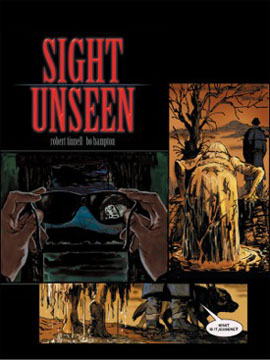 This reviewer gets scared in theaters by horror movies, but seldom on home video (the original “Ring” an exception). The occasional horror novel has sparked a chill or left a lingering feeling of dread, but when it comes to horror comics – despite a number of them bearing truly horrific ideas and tons of ghastly images – as far as communicating a true feeling of terror as in a film, that’s generally few and far between as a comic book is far easier to put down or look away from and the theatrical experience of a darkened theater is just hard to match when it comes to instilling fear.
This reviewer gets scared in theaters by horror movies, but seldom on home video (the original “Ring” an exception). The occasional horror novel has sparked a chill or left a lingering feeling of dread, but when it comes to horror comics – despite a number of them bearing truly horrific ideas and tons of ghastly images – as far as communicating a true feeling of terror as in a film, that’s generally few and far between as a comic book is far easier to put down or look away from and the theatrical experience of a darkened theater is just hard to match when it comes to instilling fear.
Well, until Robert Tinnell and Bo Hampton’s “Sight Unseen.”
There is something so insidious about
There have been ghost stories in the past that talk about how dogs and cats can see ghosts as their vision picks up a different color spectrum from humans, but none have taken that concept to the point where a blind man is able to harness that ability in a pair of optically-enhanced glasses that – in turn – allow him to see ghosts as well. Is he disturbed by this? You’d imagine at first he was, but at the point we’re picking him up, seeing ghosts is just part of his day-to-day life.
Great high-concept, but to fully relate it, you’d also want a kick-ass ghost story, too, right? Consider it delivered. With shades of Peter Straub, Tinnell takes the concept and applies it to a nasty tale of a vengeful ghost with no qualms about killing many, many people – including characters you didn’t think were going to die. “Sight Unseen” is a very bloody book and because the violence and terror brought on by the ghost is done so sparingly, it makes it that much more terrifying.
And then there’s the art. The art is both parts impressionistic and realistic, people look like people, ghosts look like ghostly-people, etc., so when you see the demonic, grinning visage of the main ghost, it’s just a bad, bad image. The fact that it shows up so rarely – and then, sometimes only when the protagonist, Frank Byron puts on his glasses (sometimes to reveal that she is right in front of him) – makes it that much worse. Combining that with a new twist on a haunted house tale and you’ve got a great comic book.
Recently, some of the more interesting horror comics have showed up as adaptations of classic short stories – notably in the pages of IDW’s “Doomed” magazine. “Sight Unseen” is a step up – a tale that is best suited to a combination of art and letters, something that wouldn’t likely be as effective in novel form, but has all the richness of storytelling that you’d expect off the Barnes & Noble shelf from a Jack Ketcham, Edward Lee or Stephen King. Just a great, great horror tale.
RATING: 
The Return of the King: Gaiman and Romita revive Kirby’s Eternals
By Jeb D.
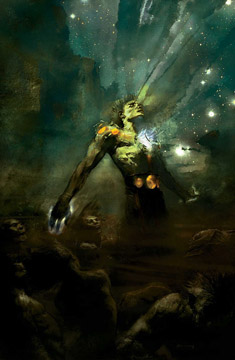 The Eternals was one of the last original creations of the legendary Jack Kirby, and when it was first published, opinion on it was seriously divided: its story of gods and monsters was either the culmination of every epic tale he’d been telling over the years, or the work of a great artist returning to the same well once too often. Inspired by the work of “Chariots of the Gods?” author Erich Von Daniken (who speculated that the ancient Earth had been visited, and its civilization shaped, by god-like beings from outer space), Kirby attempted to form a new creation myth, though one that seemed to result in the same titanic conflicts that he had created previously in Asgard or New Genesis. Like most of the work of his later period, it was met with only middling success, and was cancelled after 14 issues, amid angry denouncements of editorial interference.
The Eternals was one of the last original creations of the legendary Jack Kirby, and when it was first published, opinion on it was seriously divided: its story of gods and monsters was either the culmination of every epic tale he’d been telling over the years, or the work of a great artist returning to the same well once too often. Inspired by the work of “Chariots of the Gods?” author Erich Von Daniken (who speculated that the ancient Earth had been visited, and its civilization shaped, by god-like beings from outer space), Kirby attempted to form a new creation myth, though one that seemed to result in the same titanic conflicts that he had created previously in Asgard or New Genesis. Like most of the work of his later period, it was met with only middling success, and was cancelled after 14 issues, amid angry denouncements of editorial interference.
In the years since, Marvel’s relation with the Kirby estate have been prickly, at best, but some sort of rapprochement seems to have been reached recently: Kirby’s daughter Lisa will be bringing out Galactic Bounty Hunters, based on concepts left behind at her father’s death, through Marvel’s Icon imprint, and Marvel has evidently received the Kirby family’s blessing (not that they needed it) to revive The Eternals, in the hands of industry legends Neil Gaiman and artist John Romita, Jr., in a six-issue miniseries.
In issue #1, Gaiman tells a familiar story: a “normal” contemporary character (medical intern Mark Curry) is visited by a mysterious stranger (one Ike Harris), who tells him that he’s not who he thinks he is, and that he possesses powers, and a heritage, beyond those of ordinary men. Naturally, Curry thinks the guy’s a nut, and Ike’s attempts to persuade him otherwise provide the narrative backstory that lays out Kirby’s tale of Eternals, Celestials, and Deviants, and brings it up to date in today’s Marvel Universe. By issue’s end, we think that Mark may be starting to accept the wild tale, but of course things can never be that simple.
One of the criticisms of the earlier Eternals series was that Marvel seemed to be strongarming Kirby to bring the characters into the regular Marvel Universe, resulting in some awkward final issues. Gaiman is making the transition more smoothly, since he’s operating on that premise right from the start: a parallel storyline involves Tony (Iron Man) Stark, and there are references to the ongoing Civil War series. As an introduction, it’s skillfully handled, though as I say, it’s a setup that’s over-familiar to fans of fantasy and science-fiction (highly reminiscent of Harry Potter’s introduction to his “real” self, or the original Buffy’s—or Gaiman’s own “Neverwhere” or “Books of Magick”, for that matter). The characters are sketched quickly but clearly, and Gaiman’s introduction of the Eternal known as Sersi is particularly entertaining. And while I can’t recall Kirby ever using the “human” aliases that Gaimain gives the characters (“Ike Harris” = Ikaris, “Mark Curry” = Makkari, etc.), they’re exactly as corny as something Kirby would have come up with himself.
The choice of John Romita, Jr. on art is a logical one, since this is a sort of Marvel “heritage” project. He evokes the familiar Kirby style without aping it slavishly, and provides a much better contrast with the “mundane” world of Mark Curry than the King himself would have managed. The action is well-executed, as you’d expect from JRJr, and the flashback sequences deliver the right sense of antediluvian awe.
What’s hard to see, at this point, is how this huge story can be compellingly told in just six issues, given that we’re barely past initial introductions after one issue. It would be nice to think Gaiman has a complete tale to tell, and is not just setting us up for some new ongoing series in lesser hands than his. We’ll see.
For what it is, the setup to a story that brings ancient power into the modern world, this issue works perfectly well. Those looking for “Sandman”-style poetry will be disappointed—but, then, no one reading Kirby’s original series would expect anything like that. For better or worse, Kirby’s magnificent creations generally related to the world around them with giant “K-POW”s and “BA-ROOM”s, and Gaiman and Romita reproduce that feeling (even if they eschew the actual sound effects). Like Kurt Busiek’s Conan, the new Eternals series puts its trust in Kirby’s original concepts, and (so far, at least) isn’t going to mess with them much. How you feel about that will largely depend on how you view Kirby’s Eternals in the first place.
RATING: 
Buckaroo Banzai Comes to Comics: Laugh While You Can, Monkeyboy
By
 It seems unlikely that anyone reading this column is unfamiliar with The Adventures Of Buckaroo Banzai Across The Eighth Dimension, one of the most original and clever movies of the past fifty years. With witty dialogue driving a fast paced action/comedy, audiences were pulled into a world of sci-fi pulp fiction brought to the screen properly for the first time. Every fan has fruitlessly waited for a sequel for decades because some witless moron bought all future rights and then refused to create them. Now a comic, written by the same person that penned the film script has appeared to great anticipation.
It seems unlikely that anyone reading this column is unfamiliar with The Adventures Of Buckaroo Banzai Across The Eighth Dimension, one of the most original and clever movies of the past fifty years. With witty dialogue driving a fast paced action/comedy, audiences were pulled into a world of sci-fi pulp fiction brought to the screen properly for the first time. Every fan has fruitlessly waited for a sequel for decades because some witless moron bought all future rights and then refused to create them. Now a comic, written by the same person that penned the film script has appeared to great anticipation.
The wait was full of anticipation for the same feelings of excitement and unexpected twists to standard storylines; the wait is not yet over. With most of the movie characters being represented and the story picking up basically where the movie left off, there is a sense that we have seen this flick before. Drawn competently but not with inspiration (every face in every panel is devoid of expression), one cannot help but mentally superimpose the faces, voices, inflections and actions of the familiar actors over what is presented on the page, and the comic comes up short.
It may be the medium, with comics unable to replicate the visual action of movies. Perhaps it is the years of anticipation for another adventure that makes a truly successful transfer to our beloved medium impossible. Whatever the cause, the story reads as if it needs a rewrite. Maybe the story needs to be read in one fell swoop, as the last half of this issue reads better than the first, or maybe this is once again a graphic novel prematurely released. Whatever the cause, this is something of a letdown.
RATING: 
![]()

Conan: The Tower of the Elephant and other stories
(Dark Horse)
By Jeb D.
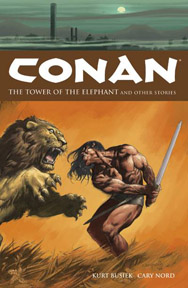 During the 1970’s, Marvel’s groundbreaking adaptation of Robert E. Howard’s Conan the Barbarian pulp stories featured art from such comics giants as Barry Windsor-Smith, Gil Kane, and John Buscema. Despite that, the artist most closely associated with the character never drew a single Conan comic panel: the legendary Frank Frazetta, whose paintings adorned the covers of the Lancer Books paperbacks that re-ignited interest in the Cimmerian, covers that were as dramatic and iconic as James Bama’s for the Doc Savage paperbacks.
During the 1970’s, Marvel’s groundbreaking adaptation of Robert E. Howard’s Conan the Barbarian pulp stories featured art from such comics giants as Barry Windsor-Smith, Gil Kane, and John Buscema. Despite that, the artist most closely associated with the character never drew a single Conan comic panel: the legendary Frank Frazetta, whose paintings adorned the covers of the Lancer Books paperbacks that re-ignited interest in the Cimmerian, covers that were as dramatic and iconic as James Bama’s for the Doc Savage paperbacks.
It’s fitting that when Dark Horse relaunched the character, they decided to provide the one element that Marvel had overlooked: sequential art by Frank Frazetta.
OK, not really. But artist Cary Nord (Daredevil, Ripley’s Believe It Or Not) illustrates the book in a style clearly modeled on those legendary cover paintings. This isn’t a criticism, by the way—Nord’s pencils (colored, but not inked) bring Frazetta’s version of Conan’s world fully alive. One might give Windsor-Smith the nod for sheer magic and mystery, or Buscema for fluid action and grit, but on balance Nord’s Conan is closer to the visual heart of the character than anyone’s been since Frazetta. The Hyborian world feels not only real, but ancient and alien. The enemies, both human and monster, are not just visually striking, but well varied in appearance, and the women are Howard’s fevered fantasies come to life. It’s a dream come true for Frazetta fans: it’s all the aspects of Conan that never got around to, and it’s handled with total conviction. Given the lack of inking, Dave Stewart’s colors take on an even greater importance than usual, and this is probably the finest work of his career (just take a look at the contrasting images on the cover: the cool moonlit nightscape atop the title, contrasted with the central wraparound of Conan facing down a lion at the moment of attack).
The scripts for the new series, by veteran Kurt Busiek, have taken a loving approach to the original stories, with narrative captions illustrated as though pages from Howard’s typewriter. The risk for modern readers coming new to Conan is much the same as movie watchers of today trying to appreciate Chaplin or Keaton: the work is so influential, and has been pillaged so many times by those of lesser abilities, that the originals inevitably lack the freshness they had for their first audiences. Busiek makes no apology for that, though, and trusts the original stories enough not to mess with them. One interesting touch that he brings is to turn Howard’s brief introductory piece, “The Nemedian Chronicles” (where an unnamed prince is having Conan’s legendary deeds read to him) into an ongoing framing sequence with its own parallel storyline. Even if you think that you’ve already seen what Conan and his successors have to offer, Busiek and Nord will draw you in and hook you.
This specific volume is the third in Dark Horse’s collected series, and while all the stories are good ones, featuring the familiar blood and intrigue, the title story is exceptional, featuring one of Howard’s strangest and most moving creations. The stories that precede it (skillfully mixing Howard and Busiek) feature enough swordplay, thievery, seduction, and treachery that the pages just seem to fly by.
Beyond the comics reprints themselves, this is a beautiful package, featuring an introduction from legendary artist Michael Kaluta (who provides a brief interlude sequence in the title story), background text piece with Nord’s sketches and test drawings, and a paper stock and binding that feel as substantial as a good hardcover.
Busiek recently left the series, and while it was probably unrealistic to expect one creative team to take the character from womb to tomb, so to speak, it is disappointing. We’ll see how things go from here on out; for now, though, these Dark Horse comics are a near-perfect introduction to Conan.
RATING: 
Walt Kelly’s Our Gang
(Fantagraphic Books)
By Elgin Carver
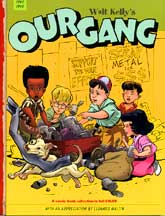 Walt Kelly is one of the true geniuses of the funny animal comic strip. Pogo, an opossum living in the Okefenokee Swamp with his animal friends, most notably Albert (the alligator), Howland (the owl), Churchy (the turtle), and Porkypine (the porkypine), commented on food, the human condition, politics, and getting out of work. Before Pogo and well deserved fame, Kelly worked on the Our Gang comic book.
Walt Kelly is one of the true geniuses of the funny animal comic strip. Pogo, an opossum living in the Okefenokee Swamp with his animal friends, most notably Albert (the alligator), Howland (the owl), Churchy (the turtle), and Porkypine (the porkypine), commented on food, the human condition, politics, and getting out of work. Before Pogo and well deserved fame, Kelly worked on the Our Gang comic book.
Other than the Three Stooges, the Our Gang one reelers are easily the most famous short films in American history. Lasting from the silent era through the early 1940s, then picked up by television from the 1950s through today, virtually every American knows and loves Spanky, Buckwheat, Alfalfa, and Darla. In these comics Kelly used his own distinctive style, which is reminiscent of Cole’s Plasticman and Frazetta work on Johnny Comet and Lil’ Abner, to bring to comic life, entirely new stories of this mismatched and creative gang of kids.
Here Fantagraphics has begun another series of books collecting important, entertaining, and obscure comics for a new audience. Reprinted in full color at a somewhat reduced size from the original comic, the quality of the printing is as good as could be expected. The original books, although entitled Our Gang, are actually an anthology with several short stories containing characters other than these young kids. This book extracts Kelly’s work from the first eight issues. Unfortunately the covers are not included, with the exception of the first two, the second greatly reduced in size. There are a pair of nice essays opening the book that give an interesting overview of the origins of both the movie series and the comic. The book is soft bound, a choice that reduces the long term value. Still, this is a welcome addition to the reprint library everyone should be accumulating while this unprecedented deluge is coming at us from so many directions.
RATING: 
BMWFILMS.com presents The HireTM
(Dark Horse)
By Jeb D.
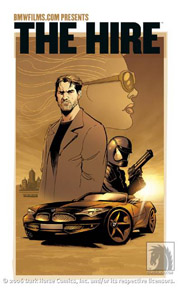 A few years back, BMW gave filmmaker David Fincher (Fight Club) a big suitcase of money to recruit some of the world’s top directors (Ang Lee, Ridley Scott, John Woo, etc.) to make a series of short online films in which a professional driver (the “Hire”, played by Clive Owen) would run BMW’s through a series of insane high-speed car chases to outdo anything seen onscreen before. They were an instant success (the DVDs were hot items on ebay), and among other things launched the less-successful “Owen for Bond” movement.
A few years back, BMW gave filmmaker David Fincher (Fight Club) a big suitcase of money to recruit some of the world’s top directors (Ang Lee, Ridley Scott, John Woo, etc.) to make a series of short online films in which a professional driver (the “Hire”, played by Clive Owen) would run BMW’s through a series of insane high-speed car chases to outdo anything seen onscreen before. They were an instant success (the DVDs were hot items on ebay), and among other things launched the less-successful “Owen for Bond” movement.
Recently, Dark Horse, in their quest to find some media adaptation they hadn’t tried yet, put together a limited series of new original stories based on the character of “The Hire”.
Unfortunately, I use the word “character” pretty loosely here. In the original films, we learn that the unnamed driver is highly professional, stoic, and somewhat better morally-centered than most of his clients. His narration is world-weary and gnomic. And that’s about it. The real story is some very glossy sports-car porn, which certainly has its place, but doesn’t necessarily translate well into comics.
Not that Dark Horse didn’t give it their best shot: the four issues collected here are loaded with some of the top names in the comic industry.
In the first story, Matt Wagner writes and draws our narrator’s encounter with the latest Paris Hilton knockoff. There’s action aplenty as she’s targeted by a group of bikers (who tape threats to their backs like “kick me” signs), but the screech of tires doesn’t translate to the comics page the way that it does onscreen. Watching an expensive car perform unbelievable feats on film is a kind of visual trickery that, when done right, can astound. Seeing an artist draw the same thing on a comics page just doesn’t have the same impact: we’ve seen artists like these draw galaxy-spanning space battles and armies of the undead; they’ve made us believe that men and women can fly. Watching a cartoon BMW take a leap over some rocks in the desert lacks something by comparison. The story’s cute, though you’ll see the “twist” coming a mile away.
Actor and genre god Bruce Campbell pens the second story, and while it’s another one that depends on some pretty predictable “surprises”, Campbell provides some nicely obsessive background into the city of Detroit and its legacy of transportation. Killian Plunkett’s art is less striking than Wagner’s, but serviceable. Mark Waid and Claude St. Aubin send our boy up against The Mob again with predictable results, and Kurt Busiek and Steven Grant team with artist Francisco Ruiz Velasco to top things off with a reminiscence of an adventure told from the point of view of one of The Hire’s clients. None of the stories are exactly bad—these pros are all too good for that—but they’re certainly not essential reading (just as the Hire short films, while entertaining, don’t provide the same satisfaction as do the best full-length films that their directors have done). Apart from the page length, they’d have made ideal backup stories in some other book (just as the online films work nicely as “short subjects” before you put “Ronin” or “Die Hard 3” in the DVD player for the umpteenth time).
As is typical of Dark Horse, the packaging is high quality (their trade paperbacks always feel substantial and look gorgeous), though there’s none of the “extras” readers have come to expect. And given that the book is priced six bucks higher than the four individual issues combined (all still available directly from Dark Horse), I really can’t give this one much of a recommendation.
RATING: 
Showcase Presents Superman: Volume 2
(DC Comics)
By Elgin Carver
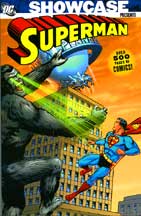 By 1960 there was a solid agreement among those in charge of DC that Superman was not only their cash cow, but that he needed to be milked dry. To do so, it was felt that his universe and abilities had to be expanded in every imaginable direction. Bizarro and his world, giant apes, Luthor’s insanity, visits to Krypton, variations on super children in alternate universes, Superman in old age, mermaids, exploding Earths, Krypto the Super Dog, dragons, Lois and her problems, and on and on. While Marvel was on the cusp of taking superheroes into a more realistic world, DC was dragging us further and further away. This book is in the center of that movement and time. A very "unreal" Superman is involved in very "unreal" situations.
By 1960 there was a solid agreement among those in charge of DC that Superman was not only their cash cow, but that he needed to be milked dry. To do so, it was felt that his universe and abilities had to be expanded in every imaginable direction. Bizarro and his world, giant apes, Luthor’s insanity, visits to Krypton, variations on super children in alternate universes, Superman in old age, mermaids, exploding Earths, Krypto the Super Dog, dragons, Lois and her problems, and on and on. While Marvel was on the cusp of taking superheroes into a more realistic world, DC was dragging us further and further away. This book is in the center of that movement and time. A very "unreal" Superman is involved in very "unreal" situations.
Yet there is a certain charm here. An innocence that is now almost extinct in the comic book format. What started in the early Marvel comics has spread, kicked on up the road by The Dark Knight’s heavy boots and sped along until almost no pure heroes are left. Everyone has foibles or weaknesses, drinks or sleeps around, kills indiscriminately or cannot kill to save the most innocent, seeks publicity or wants to be left alone by everyone. In this book is the ending of that belief that someone can have concern for others above themselves without being despicable in all other aspects of their lives. Someone can sacrifice willingly without betraying their friends or loved ones. Some silliness can be endured, even enjoyed when a purity of heart is evident.
This volume is consistent in size, cost, and materials as the other Showcase Presents and the Essential Marvel books. Marvel can bring us many books of this type, but DC has depth of material, a strong bench in sports vernacular, that Marvel cannot match. They could bring us books like this monthly for a generation if they would, and they should. This is basic comic book fun that you should not deny yourself.
RATING: 
![]()

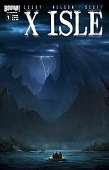 X-Isle #1 (Boom) – Like the similarly-cinematic Boom! Studios release “Talent,” “X-Isle” is a high concept-driven story about a team of sea-going researchers and their crew that find themselves marooned on an uncharted island (an unholy lightning storm destroys their research vessel) that you can already easily see translating onto screen – big or small. Like the first act of a horror movie, the characters are introduced quickly and economically – the professor whose daughter says, “I just wish for once you’d stop being Dr. Keller and start being my dad,” the daughter’s love interest who is the researcher-father’s assistant, the other wacky scientist who wears water wings, but prefers them called “personal floatation devices,” the grizzled ship captain and his Samoan (Maori?) second-in-command and so on – before the boat is destroyed and they’re stuck on what is, according to the last few panels, a rather monster-filled island that may sport creatures unknown to mankind for millennia. Cut from the same cloth as everything from the “Jurassic Park” movies and “Creature from the Black Lagoon” to “Deep Rising” (this reviewer’s fave) and “Anaconda,” “X-Isle” promises to be a rollicking, monster-filled adventure that hearkens back to the pulpy adventure tales of yesteryear. –Mark
X-Isle #1 (Boom) – Like the similarly-cinematic Boom! Studios release “Talent,” “X-Isle” is a high concept-driven story about a team of sea-going researchers and their crew that find themselves marooned on an uncharted island (an unholy lightning storm destroys their research vessel) that you can already easily see translating onto screen – big or small. Like the first act of a horror movie, the characters are introduced quickly and economically – the professor whose daughter says, “I just wish for once you’d stop being Dr. Keller and start being my dad,” the daughter’s love interest who is the researcher-father’s assistant, the other wacky scientist who wears water wings, but prefers them called “personal floatation devices,” the grizzled ship captain and his Samoan (Maori?) second-in-command and so on – before the boat is destroyed and they’re stuck on what is, according to the last few panels, a rather monster-filled island that may sport creatures unknown to mankind for millennia. Cut from the same cloth as everything from the “Jurassic Park” movies and “Creature from the Black Lagoon” to “Deep Rising” (this reviewer’s fave) and “Anaconda,” “X-Isle” promises to be a rollicking, monster-filled adventure that hearkens back to the pulpy adventure tales of yesteryear. –Mark
RATING: 
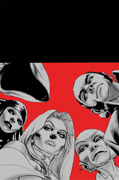 Astonishing X-Men #15 (Marvel). While we likely still have much to learn about Emma Frost’s motivations, her plan to help the Hellfire Club take down the X-Men is going along swimmingly. After psychologically crippling Cyclops in the last issue, she sets her cohorts loose on the rest of the team, and by issue’s end, Colossus, Beast, and Wolverine have been taken out of action in some delightfully varied ways. Elsewhere, the other threads of the story that have been building since issue #1 weave closer together as two of the team’s other powerful foes find common cause, the extra-planetary group S.W.O.R.D. uncovers the identity of the “Destroyer of Worlds”, and the issue wraps up with writer Joss Whedon’s beloved Kitty Pryde ready to lead the counterattack, with a final panel that will tickle longtime fans. Throughout the book, artist John Cassaday mixes brisk action with quieter character moments (Emma Frost’s efforts to produce a tear are chilling). Really, apart from Grant Morrison’s tenure, the X-Men haven’t been this much fun in years, and Astonishing might even get the edge over Morrison’s New X-Men due to the consistent quality of the art. –Jeb D.
Astonishing X-Men #15 (Marvel). While we likely still have much to learn about Emma Frost’s motivations, her plan to help the Hellfire Club take down the X-Men is going along swimmingly. After psychologically crippling Cyclops in the last issue, she sets her cohorts loose on the rest of the team, and by issue’s end, Colossus, Beast, and Wolverine have been taken out of action in some delightfully varied ways. Elsewhere, the other threads of the story that have been building since issue #1 weave closer together as two of the team’s other powerful foes find common cause, the extra-planetary group S.W.O.R.D. uncovers the identity of the “Destroyer of Worlds”, and the issue wraps up with writer Joss Whedon’s beloved Kitty Pryde ready to lead the counterattack, with a final panel that will tickle longtime fans. Throughout the book, artist John Cassaday mixes brisk action with quieter character moments (Emma Frost’s efforts to produce a tear are chilling). Really, apart from Grant Morrison’s tenure, the X-Men haven’t been this much fun in years, and Astonishing might even get the edge over Morrison’s New X-Men due to the consistent quality of the art. –Jeb D.
RATING: 
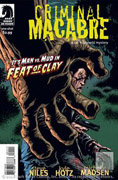 Criminal Macabre: Feat of Clay (Dark Horse) – Yay! A new Cal McDonald story with art from Kyle Hotz! Over the past couple of years, horror comic maestro Steve Niles has put his stamp on almost every last major piece of horror mythos there is – vampires, Frankenstein’s monster, Dr. Jekyll & Mr. Hyde, werewolves, zombies, Satanists, demonic possession, mutant-freaks, ghouls, aliens, giant monsters, even a haunted car – so when you see him taking on a tale of the Golem, it’s safe to wonder just how much gas is left in the car (haunted or otherwise). But with the excellent one-shot “Criminal Macabre” mystery, “Feat of Clay,” Niles proves there’s plenty of fuel in his tank as all the sarcastic fun of a Cal McDonald story mixed with a really well-conceived Golem-driven revenge tale makes for a great adventure. Basically, Cal gets called in on a job where an old guy creates a Golem to get justice for his daughter after she was attacked by a random scumbag. The old guy is so shocked that the Golem worked that he immediately had a heart attack and died, leaving the Golem on the loose and Cal the only one who can deal with it. What results is a beautifully rendered tale that blends Cal’s fine wit with bone-crunching violence. Maybe Dark Horse should consider a whole run of these one-shots. God knows it would be a welcome addition to the horror titles currently out there. –Mark
Criminal Macabre: Feat of Clay (Dark Horse) – Yay! A new Cal McDonald story with art from Kyle Hotz! Over the past couple of years, horror comic maestro Steve Niles has put his stamp on almost every last major piece of horror mythos there is – vampires, Frankenstein’s monster, Dr. Jekyll & Mr. Hyde, werewolves, zombies, Satanists, demonic possession, mutant-freaks, ghouls, aliens, giant monsters, even a haunted car – so when you see him taking on a tale of the Golem, it’s safe to wonder just how much gas is left in the car (haunted or otherwise). But with the excellent one-shot “Criminal Macabre” mystery, “Feat of Clay,” Niles proves there’s plenty of fuel in his tank as all the sarcastic fun of a Cal McDonald story mixed with a really well-conceived Golem-driven revenge tale makes for a great adventure. Basically, Cal gets called in on a job where an old guy creates a Golem to get justice for his daughter after she was attacked by a random scumbag. The old guy is so shocked that the Golem worked that he immediately had a heart attack and died, leaving the Golem on the loose and Cal the only one who can deal with it. What results is a beautifully rendered tale that blends Cal’s fine wit with bone-crunching violence. Maybe Dark Horse should consider a whole run of these one-shots. God knows it would be a welcome addition to the horror titles currently out there. –Mark
RATING: 
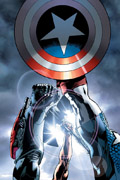 Ultimates Volume 2 #11 (Marvel) – As “America Strikes Back”, writer Mark Millar and artist Bryan Hitch send Captain America and his badly-outnumbered team against the international super-invaders that now hold America in their power (don’t even try to ask where this fits in Ultimate continuity, just go with it). While Hitch provides the most gleefully smashing action sequences around, Millar’s marshaling story elements (have we finally figured Thor out? Is Hank Pym irredeemable? What the hell will Iron Man Six look like?) for what promises to be the comics throwdown of the decade as the series wraps up in the next two issues. While Millar’s script is breezy and fun, it’s Hitch’s pencils that send your jaw to the floor over and over (from details like the polish on Cap’s shield to the Perez-like full-page panels crammed with characters— hell, he shows us cavities in The Abomination’s teeth!). Millar and Hitch don’t make things easy for Cap, though—he’s not simply mopping the floor with bad guys: he’s strategizing with the forces at hand, hoping for a breakthrough, and as things start to go badly, it looks like he’s going to get one, and in spades. This comic remains the most outright “smash-em-up” superhero fun being published today, and it’s just a darn shame that this perfect marriage of characters and creators will sunder in a few short months. I’ll miss ‘em. – Jeb D.
Ultimates Volume 2 #11 (Marvel) – As “America Strikes Back”, writer Mark Millar and artist Bryan Hitch send Captain America and his badly-outnumbered team against the international super-invaders that now hold America in their power (don’t even try to ask where this fits in Ultimate continuity, just go with it). While Hitch provides the most gleefully smashing action sequences around, Millar’s marshaling story elements (have we finally figured Thor out? Is Hank Pym irredeemable? What the hell will Iron Man Six look like?) for what promises to be the comics throwdown of the decade as the series wraps up in the next two issues. While Millar’s script is breezy and fun, it’s Hitch’s pencils that send your jaw to the floor over and over (from details like the polish on Cap’s shield to the Perez-like full-page panels crammed with characters— hell, he shows us cavities in The Abomination’s teeth!). Millar and Hitch don’t make things easy for Cap, though—he’s not simply mopping the floor with bad guys: he’s strategizing with the forces at hand, hoping for a breakthrough, and as things start to go badly, it looks like he’s going to get one, and in spades. This comic remains the most outright “smash-em-up” superhero fun being published today, and it’s just a darn shame that this perfect marriage of characters and creators will sunder in a few short months. I’ll miss ‘em. – Jeb D.
RATING: